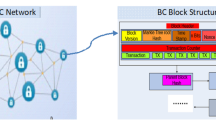Abstract
The right to personal privacy is known as a fundamental human right allowing people to restrict access to their personal information. The decentralized nature of blockchain networks, often involving the publicity of ledger information, can come into conflict with this right. This is in particular the case when the blockchain maintains sensitive information such as financial credits or medical information. In this paper, we discuss this interaction. We first describe multiple aspects of privacy such as its practical limit towards authorities, its potential vulnerability, and its association with technological systems such as blockchain networks. Towards answering these challenges, we survey a wide range of techniques relying on tools from the areas of cryptography, distributed system, and hardware architecture. We explain how each can be used to enhance privacy in blockchain networks following their unique nature. We further conclude that none of the available techniques can fully answer the complex practical requirements, and that practical solutions should combine both centrally controlled and decentralized systems.
Similar content being viewed by others
References
Nakamoto S (2009) Bitcoin: A peer-to-peer electronic cash system. [Online]. Available: http://bitcoin.org/bitcoin.pdf
William S (1999) Cryptography and network security: Principles and practice. Prentice-Hall Inc, Hoboken
Wood G (2014) Ethereum: A secure decentralised generalised transaction ledger. [Online]. Available: http://gavwood.com/Paper.pdf
Catalini C, Gans J S (2016) Some simple economics of the blockchain. National Bureau of Economic Research, Tech. Rep.
(1948) Universal declaration of human rights. [Online]. Available: http://www.un.org/en/universal-declaration-human-rights/
Onn Y, et al. (2005) Privacy in the digital environment. Haifa Center of Law & Technology: 1–12
Activism: Cypherpunks (1992) [Online]. Available: https://www.activism.net/cypherpunk/crypto-anarchy.html
Bø EE, Slemrod J, Thoresen TO (2015) Taxes on the internet: Deterrence effects of public disclosure. American Economic Journal: Economic Policy 7(1):36–62
Moore G E (1965) Cramming more components onto integrated circuits. Electronics 38(8):114–117
Theis T N, Wong H P (2017) The end of Moore’s Law: A new beginning for information technology. Comput Sci Eng 19(2):41–50
Anders G (2017) The obsolescence of privacy. CounterText 3(1):20–46
(2016). Regulation (EU) 2016/679 of the European parliament and of the council. Official Journal of the European Union (OJ) 59(1-88):294
Zarsky T Z (2016) Incompatible: The GDPR in the age of big data. Seton Hall L Rev 47:995
Finn RL, Wright D, Friedewald M (2013) Seven types of privacy. In: European data protection: coming of age. Springer, Dordrecht, pp 3–32
Dierks T (2008) The Transport Layer Security (TLS) Protocol, RFC 5246
Jauernig P, Ahmad-Reza S, Emmanuel S (2020) Trusted execution environments: properties, applications, and challenges. IEEE Security & Privacy 18(2):56–60
Kremer S, Jacomme C (2021) An extensive formal analysis of multi-factor authentication protocols. ACM Trans Priv Secur 24(2)
Bonneau J, Herley C, Van Oorschot PC, Stajano F (2012) The quest to replace passwords: a framework for comparative evaluation of web authentication schemes. In: IEEE Symposium on Security and Privacy
Goldwasser S, Micali S, Rackoff C (1989) The knowledge complexity of interactive proof systems. SIAM J Comput 18(1):186–208
Micali S (2000) Computationally sound proofs. SIAM J Comput 30(4):1253–1298
Arora S, Lund C, Motwani R, Sudan M, Szegedy M (1998) Proof verification and the hardness of approximation problems. J ACM (JACM) 45(3):501–555
Ishai Y, Mahmoody M, Sahai A (2012) On efficient zero-knowledge PCPs. In: Theory of cryptography conference, pp 151–168
Groth J (2010) Short non-interactive zero-knowledge proofs. In: International conference on the theory and application of cryptology and information security. Springer, Berlin, pp 341–358
Ben-Sasson E, Chiesa A, Tromer E, Virza M (2014) Succinct non-interactive zero knowledge for a von Neumann architecture. In: USENIX Security Symposium (USENIX, Security), pp 781–796
Rotter P, Daskala B, Compano R (2008) RFID implants: Opportunities and and challenges for identifying people. IEEE Technol Soc Mag 27(2):24–32
Microsoft (2009) Perimeter Firewall Design. [Online]. Available: https://docs.microsoft.com/en-us/previous-versions/tn-archive/cc700828(v=technet.10)
Gudgeon L, Moreno-Sanchez P, Roos S, McCorry P, Gervais A (2020) SoK: Layer-two blockchain protocols, financial cryptography and data security (FC)
Poon J, Dryja T (2016) The Bitcoin lightning network: scalable off-chain instant payments
The Raiden network. [Online]. Available: https://raiden.network/
Poon J, Buterin V (2017) Plasma: scalable autonomous smart contracts, White paper
Teutsch J, Reitwießner C. (2017) A scalable verification solution for blockchains. [Online]. Available: https://people.cs.uchicago.edu/teutsch/papers/truebit.pdf
Kalodner H A, Goldfeder S, Chen X, Weinberg S M, Felten E W (2018) Arbitrum: scalable, private smart contracts. In: USENIX Security symposium
Gervais A, Karame G O, Gruber D, Capkun S (2014) On the privacy provisions of Bloom filters in lightweight Bitcoin clients. In: ACM annual computer security applications conference
Reid F, Harrigan M (2013) An analysis of anonymity in the bitcoin system. In: Security and privacy in social networks, pp 197–223
Ben-Sasson E, Chiesa A, Garman C, Green M, Miers I, Tromer E, Virza M (2014) Zerocash: Decentralized anonymous payments from bitcoin in IEEE Symposium on Security and Privacy
Tran M, Luu L, Suk Kang M, Bentov I, Saxena P (2018) Obscuro: A bitcoin mixer using trusted execution environments. In: Annual computer security applications conference, pp 692–701
van Saberhagen N (2014) CryptoNote v2.0. [Online]. Available: https://github.com/monero-project/research-lab/blob/master/whitepaper/whitepaper.pdf
Rivest R L, Shamir A, Tauman Y (2001) How to leak a secret. In: ASIACRYPT
Merkle R C (1979) Secrecy, authentication, and public key systems. PhD thesis, Stanford
Gentry C (2009) A fully homomorphic encryption scheme, vol 20(9). Stanford: Stanford University
Beerliová-Trubíniová Z, Hirt M (2008) Perfectly-secure MPC with linear communication complexity in Theory of Cryptography (TCC)
Cheng R, et al. (2018) Ekiden: a platform for confidentiality-preserving, trustworthy, and performant smart contract execution, arXiv:1804.05141
Basic Attention Token (BAT) (2018) [Online]. Available: https://whitepaper.io/coin/basic-attention-token
Vazirani A A, O’Donoghue O, Brindley D, et al. (2020) Blockchain vehicles for efficient medical record management. NPJ Digital Medicine 3(1)
Author information
Authors and Affiliations
Corresponding author
Additional information
Publisher’s note
Springer Nature remains neutral with regard to jurisdictional claims in published maps and institutional affiliations.
Rights and permissions
About this article
Cite this article
Noam, O., Rottenstreich, O. Realizing privacy aspects in blockchain networks. Ann. Telecommun. 77, 3–12 (2022). https://doi.org/10.1007/s12243-021-00861-z
Received:
Accepted:
Published:
Issue Date:
DOI: https://doi.org/10.1007/s12243-021-00861-z




